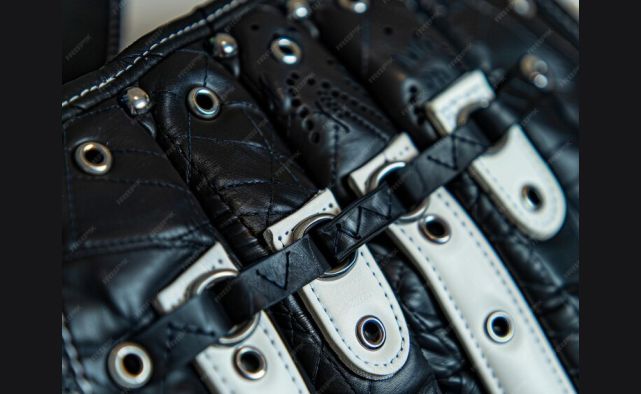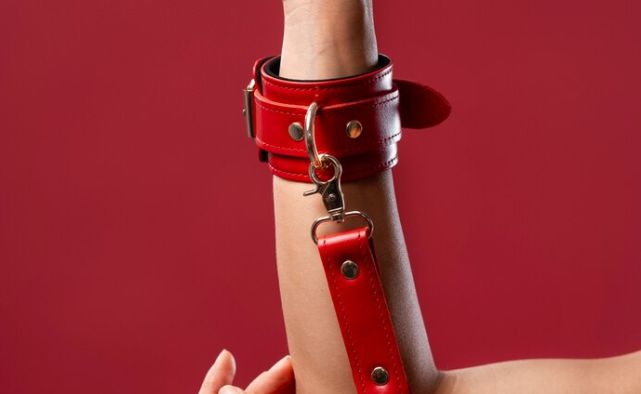If you’ve ever been curious about why leather fetish plays such a huge role in BDSM fetishism, you’re not alone. Leather isn’t just a material, it’s a symbol, a feeling, and an experience that’s deeply embedded in the BDSM culture.
Whether it’s the distinct texture, the way it smells, or the visual power it projects, leather has a magnetic pull for many.
In this article, you’ll learn why leather is so connected to dominance, submission, and roleplay, and how it has shaped BDSM culture through the years.
Recommended: Who is Dominatrix?
What is Leather Fetish?
A leather fetish is when you’re drawn to leather, not just for its look but for the way it feels, smells, and even sounds.
It goes beyond fashion or style, it’s about the sensory experience that leather brings.
You might find yourself captivated by leather clothing like jackets, pants, or skirts, or maybe it’s the leather accessories that catch your eye, such as collars, harnesses, or whips.
Leather Fetish as an Identity
For many, leather is a part of their identity within the BDSM community. It acts as a uniform that connects people, signaling a shared understanding and sense of belonging.
The look and feel of leather can also trigger memories of past experiences, linking its scent or texture to moments of pleasure or exploration.
This connection helps define who they are and how they express their desires.
Recognizing the role leather plays in shaping one’s identity within BDSM is key to understanding its deeper significance in the culture and personal experiences.
The Historical Context of Leather in BDSM
Leather’s role in BDSM has deep roots, dating back to mid-20th century leather bars and motorcycle clubs.
These spaces became refuges for those marginalized by mainstream society, where leather symbolized masculinity, rebellion, and belonging.
As leather gear like jackets, vests, harnesses, and chaps gained popularity, it became a tool for expressing power dynamics, dominance and submission during BDSM play.
The texture and visual appeal of leather added to its sensual and authoritative role in the scene.
Over time, leather evolved into a cultural symbol, especially within the “leather community,” highlighting inclusivity and resilience.
Today, leather remains a core element in BDSM, both for its history and the sense of freedom it offers in expressing desires.
Related: What is BDSM Bondage and Restraint?
The Psychology Behind Leather Fetishism

When it comes to leather fetishism, the attraction runs deeper than just the look of the material.
It’s about sensory experiences, power dynamics, and emotional connections.
Leather’s texture and durability create a unique tactile sensation that can heighten arousal, especially when it brushes against your skin.
The scent of leather can stir up emotions or memories, intensifying the experience even more.
Plus, leather attire, whether it’s jackets, harnesses, or collars, has a visual appeal that plays into dominance or submission, helping you step into your role within BDSM.
Leather as a Symbol of Power
Leather isn’t just a material; it’s a symbol. In BDSM, leather often represents strength, resilience, and authority.
It allows you to express dominance or submission visually, making it a powerful part of your identity in the scene.
When you wear leather or use it in your BDSM practice, you’re marking your role and reinforcing the power exchange.
It’s a form of self-expression that connects you to the community and helps you feel grounded in your desires.
Trust and Connection in Leather Fetishism
In BDSM relationships, incorporating leather goes beyond physical attraction, it’s about trust and mutual consent.
Choosing to include leather in your dynamic shows an understanding of boundaries and roles.
This conscious decision builds intimacy, both emotional and sexual, allowing you to explore your desires in a safe and connected way.
Leather becomes more than a fetish; it’s a key part of the relationship that deepens trust and communication.
Common Leather Items in BDSM

Leather is a powerful material in BDSM, not just because of its texture but also because of its connection to authority and control.
You’ll find a variety of leather items that are commonly used, each playing a role in shaping the dynamics between dominant and submissive partners.
1. Leather Harnesses
Leather harnesses are one of the most popular items in BDSM, serving both functional and aesthetic purposes.
They’re not just about looking good; they also provide a sense of restraint and control.
Wearing a leather harness can make the power exchange more intense, clearly signaling your role in the scene.
Whether you’re the dominant or submissive, a harness helps define your position and enhances the experience.
2. Leather Collars
A leather collar, typically worn by the submissive partner, symbolizes trust and commitment in BDSM relationships.
It represents ownership and the bond between you and your partner.
The design can vary from simple bands to more intricate styles with spikes or charms.
The collar is often part of rituals and serves as a physical reminder of your connection and roles.
3. Leather Cuffs
Leather cuffs are used for restraining wrists or ankles, adding an extra layer of physicality to the scene.
Whether they are simple or elaborate, cuffs keep you in place and heighten the experience of submission.
Some even come with locking mechanisms for extra security, giving both partners more control over the situation.
4. Leather Whips and Paddles
Leather whips and paddles are used for spanking, striking, or stimulating the skin.
The sharp crack of a whip or the sting of a paddle can add intensity to the power dynamic, heightening the physical and psychological effects of BDSM.
These tools allow you to explore your limits in a safe and consensual way, reinforcing the roles of dominance and submission.
The Role of Leather Fetish in Power Dynamics
In BDSM, leather plays a crucial role in shaping the power dynamics between you and your partner.
It’s not just a fabric choice, it’s a tool that reinforces the relationship’s dominance and submission elements.
Leather as a Symbol of Role Play
When you wear leather, it’s more than just the look; it signals a shift in identity.
For the dominant partner, leather gear boosts confidence and emphasizes control. It’s a visual marker of authority.
On the other hand, for a submissive, being dressed in leather often signifies giving up power, aligning with the role of surrender.
This change in identity heightens the psychological experience of BDSM, where the material takes on deeper significance beyond just its texture.
Sensory Stimulation and Focus
Leather’s texture, weight, and scent enhance your sensory experience during BDSM play.
The feel of leather against your skin can increase arousal and focus, making the power exchange more intense.
This tactile stimulation plays into the experience, drawing you deeper into the dynamic and adding layers to the connection you share with your partner.
Leather as a Boundary Setter
Leather also helps set clear boundaries and agreements within BDSM. When you incorporate it into your scenes, it’s often a sign of mutual understanding.
Both of you know the roles you’re stepping into, and the act of wearing leather establishes the safety and trust that’s vital in these types of relationships. It helps clarify the roles, ensuring both partners can explore freely within agreed-upon limits.
Expression and Empowerment
Leather is not just a fetish; it’s a medium for self-expression and empowerment in BDSM.
Through the act of wearing or using leather items, you can express your desires, explore your roles, and delve deeper into the emotional and psychological aspects of power play.
It transforms an experience into something much more than just physical—it becomes an emotional and psychological journey.
Safety and Communication in Leather Play
When you bring leather into BDSM play, communication and consent become even more important.
Before using any leather items, it’s crucial to set clear boundaries and expectations.
1. Consent
Consent isn’t just agreeing to play; it means ongoing discussions about your limits, desires, and safe words.
2. Clear Communication and Safe Words
Safe words are your signal to stop or adjust any activity. Choose terms you both understand and feel comfortable using.
This allows you to communicate during the session, making sure everyone feels safe and in control.
Open, honest communication builds trust and makes the experience more enjoyable for both of you.
3. Leather Gear Safety
Leather gear can look striking, but it’s important to ensure safety when using it.
Before you begin, inspect your leather restraints or items for any damage.
Make sure they fit properly, and know how they function. Avoid using leather gear that could restrict circulation for long periods to prevent discomfort or injury.
Keep checking in with your partner throughout the session to make sure everything feels okay.
4. Aftercare: Vital for Well-being
Aftercare is just as important as the session itself. After using leather in BDSM, offer emotional and physical support to your partner.
This can include cuddling, talking about the experience, or simply checking in.
Open communication during aftercare helps you both process emotions and strengthen your bond.
Leather Fetish in the Modern BDSM Community
Leather fetishism has a strong presence in today’s BDSM community, continuously evolving alongside other practices.
In the modern scene, leather is no longer just about appearance; it represents deeper themes of power exchange, identity, and belonging.
Over time, leather has merged with various BDSM practices, creating a rich and diverse experience for everyone involved.
Leather as a Symbol of Power Exchange
As has been mentioned throughout this article, leather is now a key symbol in expressing dominance and submission. Its texture, scent, and visual appeal create a sensory experience that connects deeply with many in the BDSM world.
Whether it’s used during rope play, impact play, or other forms of BDSM, leather enhances the tactile and psychological aspects of the experience.
This powerful connection supports themes of bondage, discipline, sadism, and masochism, making leather a central element in many BDSM scenes.
Leather Gear and Fashion in BDSM
The leather fetish has expanded into a wide variety of items, from simple cuffs to complex harnesses.
These accessories and garments cater to different preferences and identities, influencing modern BDSM fashion.
Wearing leather helps participants express their kinks and intensify their experiences.
It’s a form of personal expression that brings the community closer, allowing individuals to share values and experiences.
Leather-Themed Events and Community
Leather-themed events, like leather pride festivals, offer a space for like-minded people to connect and celebrate their passion for leather and BDSM.
These gatherings are vital in creating inclusivity and strengthening the sense of solidarity within the BDSM community.
As the culture grows, leather continues to serve as a powerful symbol of empowerment, creativity, and connection.
Conclusion
Leather plays a vital role in shaping BDSM culture, transcending its physical qualities to become a symbol of power, identity, and connection.
Whether it’s the sensory appeal, the way it enhances power dynamics, or its role in signaling dominance and submission, leather remains a central element in the scene.
As the BDSM community evolves, leather’s significance grows, offering both a means of personal expression and a sense of belonging.
The ongoing dialogue about its use in BDSM practices and events ensures that leather will continue to serve as a strong, enduring symbol within the community.

